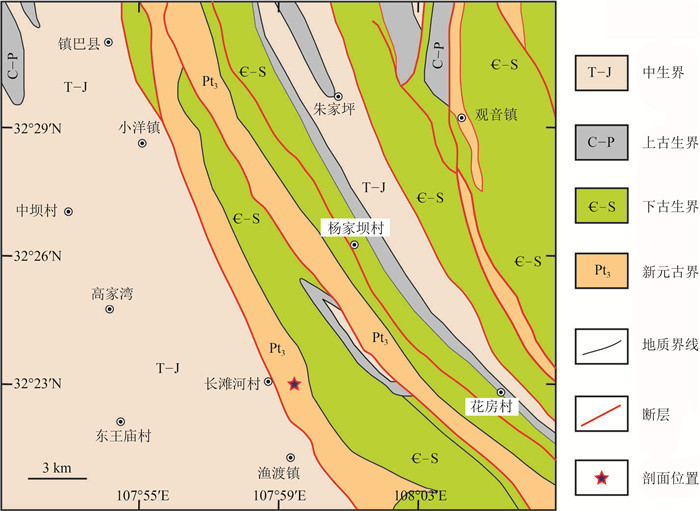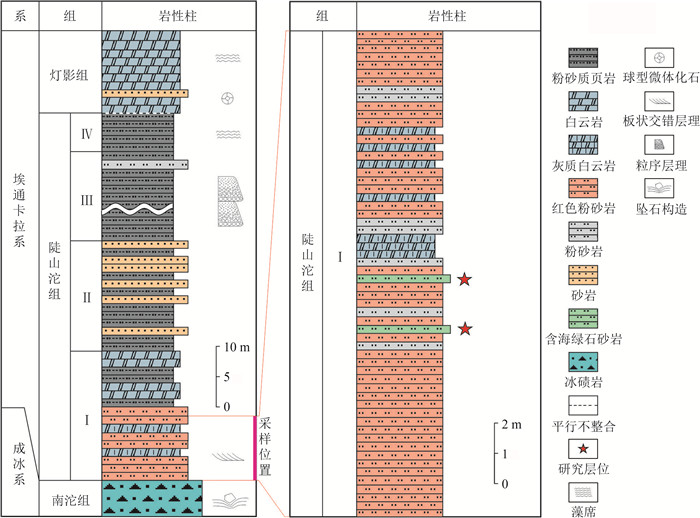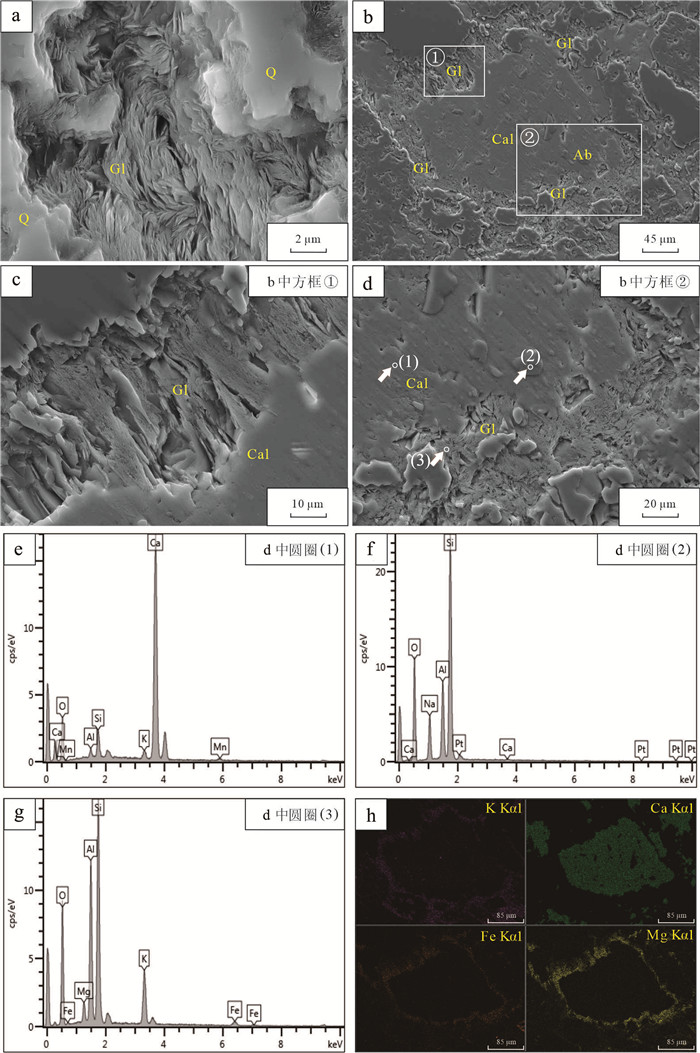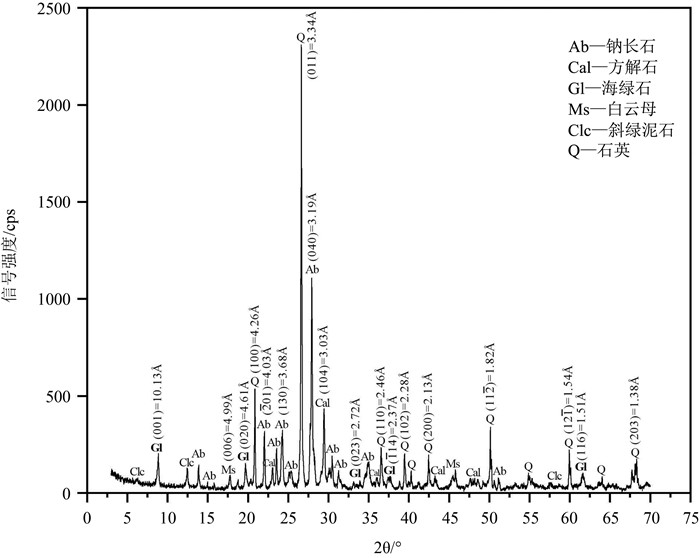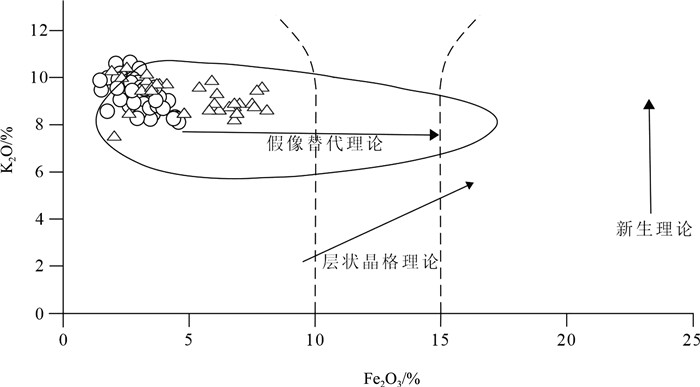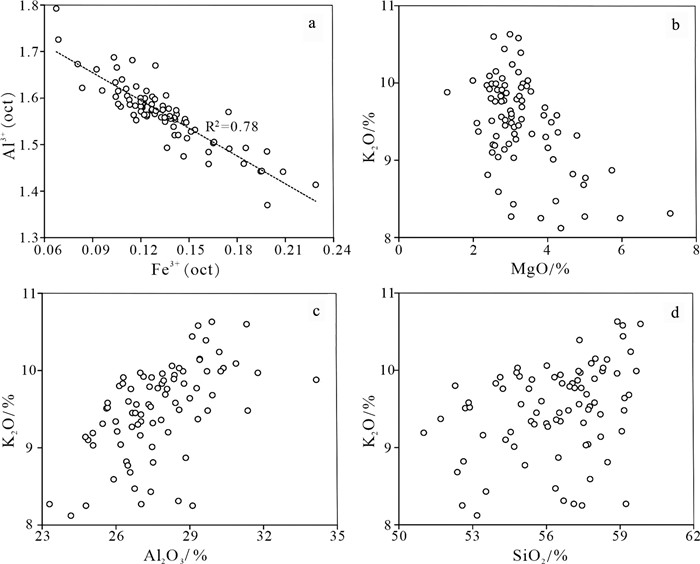The genesis of glaucony in the lower Ediacaran Doushantuo Formation, southern Shaanxi: implication to seawater redox condition
-
摘要:
海绿石是海洋环境中一类重要的自生矿物,在古环境研究方面具有广泛的应用。基于中国陕南地区埃迪卡拉纪陡山沱组下部海绿石的分布特征,对其开展了综合的岩相学、原位微区成分定量分析、X-射线衍射(XRD)分析等研究,旨在探讨海绿石的形成机制,剖析研究区埃迪卡拉纪早期的氧化还原环境。偏光显微镜和扫描电镜(SEM)观察结果表明,海绿石多以胶体沉淀物的形式充填于石英、长石等碎屑矿物颗粒之间的孔隙中,为早期成岩阶段自生沉淀成因。由于海绿石的形成需要Fe(Ⅱ)和Fe(Ⅲ)的同时存在,Fe氧化还原界面附近(次氧化)最有利于海绿石的发育,因此研究区陡山沱组下部海绿石的形成指示了次氧化的孔隙水条件。能谱(EDS)定量分析表明,研究区陡山沱组的海绿石具有高K2O和Al2O3、低Fe2O3含量,该化学组分是前寒武纪海绿石的典型特征。碎屑矿物溶解及海水与孔隙水之间的物质交换提供了海绿石演化过程所需的元素。与贵州瓮安地区同时期的含海绿石地层相比,研究区海绿石的分布层位相对局限,表明古海水氧化还原环境和古地理环境对于海绿石分布位置具有共同调控作用。
Abstract:Glaucony is an important authigenic mineral in marine environment and has been widely used in palaeoenvironmental research.In this study, we report the occurrence of the glaucony in the lower Ediacaran Doushantuo Formation in southern Shaanxi Province for the first time.Integrated studies including petrography, in-situ microanalysis and X-ray diffraction(XRD)are carried out to constrain the diagenesis of the glaucony and the oceanic redox condition in the early Ediacaran of this area.Microscopic observations using polarizing microscope and scanning electron microscope(SEM)show that the glaucony mainly fills the pores of quartz, feldspar and other clastic minerals in the form of colloidal precipitates, suggesting authigenic precipitation during the early diagenesis.Since both Fe(Ⅱ)and Fe(Ⅲ)are simultaneously required for glauconitization, glaucony prefers to precipitate around the Fe redoxcline(suboxic conditions).Accordingly, the occurrence of glaucony in the lower Doushantuo Formation of study section implies suboxic pore water environments.The results of energy dispersive spectroscopy(EDS)show that the glaucony is characterized by high K2O and Al2O3 but low Fe2O3 contents which are typical of Precambrian glaucony.The dissolution of detrital minerals along with ion exchange between the seawater and pore-water supplied the elements required for glaucony formation.Compared with contemporaneous glaucony-bearing strata in Weng'an area, Guizhou, the limited vertical distribution of glaucony in the study area indicates that the marine redox condition and paleogeography may have played a joint role in regulating the formation and spread of glaucony.
-
Keywords:
- palaeoceanography /
- Lianghekou /
- Doushantuo Formation /
- clay /
- redox
-
浅覆盖区覆盖层的地质调查和研究与深部隐伏基岩的物性、构造特征研究密不可分。一方面,深部基岩面构造特征制约了上覆盖层的沉积演化,沉积层中的同沉积构造变形可进一步细化区域构造演化史,另一方面,沉积物也可以通过侵蚀、搬运、负载等方式对基岩的构造特征进行改造,二者是一对耦合关系。常规的地表地质调查很难获得隐伏基岩及断裂的特征信息,故本次研究采用地质钻探与重力异常相结合的方法进行重力异常钻孔约束反演,重力位场数据横向分辨能力较高,地质钻孔数据可提供岩石物性特征并进行深度约束,因此,可有效减少重力异常数据地质解释的多解性,构建较准确的基岩地质模型。研究区郯庐断裂带泗洪地区距离曾发生8.5级地震的郯城仅130余千米,由于该区域被第四纪—新近纪沉积物广为覆盖,前人对其深部构造特征的研究较薄弱,故本次研究结合区域第四纪—新近纪覆盖层沉积结构,探讨断裂的空间展布特征,具有一定科学意义。
1. 区域地质及基岩物性特征
1.1 区域地质背景
郯庐断裂带是贯穿中国东部大陆边缘的一条NNE向走滑剪切断裂带。研究表明,这条断裂在晚新生代仍然活动,是一条重要的地震活动带,其分段特征明显,从南到北可分为苏皖段、山东段及东北段3段[1-2], 其中苏皖段途经地区人口稠密、经济发达,受到国内外学者的广泛关注。中生代以来,郯庐断裂带经历了华南-华北板块碰撞、太平洋板块俯冲,以及白垩纪、古近纪强烈的地幔热作用等一系列重大地质事件,构造演化复杂[3-5]。第四纪以来,郯庐断裂带依然活动频繁,发生过多次中强级以上地震,如1668年莒县-郯城8.5级地震,1888年渤海湾7.5级地震,1969年渤海7.4级地震,1975年海城7.3级地震等,其中1668年莒县-郯城8.5级地震是中国东部有记录的最强烈的地震。郯庐断裂带泗洪地区位于郯城以南约130 km,归属郯庐断裂带苏皖段的中北部,位于华北板块、苏鲁造山带及扬子板块的结合部位(图 1-a),该地区被第四纪—新近纪沉积物大面积覆盖(图 1-b),基岩及断裂以隐伏断裂为主,仅在重岗山、朱山附近有基岩出露。前人认为,郯庐断裂带在泗洪地区主要由山左口-泗洪断裂(F1)、新沂-新店断裂(F2)、墨河-凌城断裂(F3)、王集-朱山断裂(F4)和桥北镇-宿迁断裂(F5)5条分支断裂延伸组成,宽20~30 km,其中F2、F3和F4分别由山东段的安丘-莒县断裂、沂水-汤头断裂和鄌郚-葛沟断裂延续而来[1, 4, 6-7]。该区域性断裂带西靠华北板块,东临苏鲁造山带,同时受到邻近扬子板块挤压、东侧太平洋板块俯冲及远端喜马拉雅抬升的共同作用,构造演化极其复杂,前人将郯庐断裂带的构造演化总结为4个阶段,分别为早中生代左旋转换走滑,晚侏罗世—早白垩世早期左行平移,早白垩世—古近纪大规模伸展正断及新近纪以来挤压逆冲兼具右行走滑[8-18]。不同区段内部受物性结构及动力学背景差异影响,构造演化特征存在偏差。根据采取的研究手段精度及研究时间尺度的不同,对郯庐断裂带构造演化仍存在争议,如万天丰等[19]将其演化总结为:1次左行走滑(250~208 Ma);2次正断层(135~52 Ma与23.3~0.73 Ma);3次挤压逆冲断层(208~135 Ma、52~23.3 Ma、0.73 Ma以来)。而张岳桥等[20]将郯庐断裂带中生代的运动学演化概括为“两大运动时期、五个发展阶段”。Li等[21]的研究显示,郯庐断裂带泗洪地区缺失古近纪地层,指示泗洪地区在晚白垩世末期—古近纪经历挤压抬升,同时泗洪县南部的反射地震剖面显示其下伏断裂为第四纪正断层,说明郯庐断裂带部分地区在第四纪仍处于伸展状态。
1.2 基岩地层及物性特征
泗洪地区仅沿郯庐断裂带零星分布的孤丘可见基岩露头,为中—新元古代地层组成的丘陵岗地,其余大部分地区被第四纪松散层覆盖,其沉积厚度差异较大、地层发育不全。
基岩地层单元以郯庐断裂带为界,划分为3个大区,西侧属华北地层区,在朱山附近出露新元古代八公山群兰陵组(Pt3l)及九顶山组上段(Pt3jd2),分别为石英岩及微晶灰岩;断裂带内为晚白垩世红色砂岩、砂砾岩,在重岗山地区出露,岩石普遍风化较强,砂砾岩中砾石主要为片麻岩巨砾、漂砾,且沿重岗山东、西两侧分别可见其逆冲于新近系、第四系之上,断层走向近正北;东侧为苏鲁造山带锦屏岩群,地表未见露头,钻孔揭露显示基底为花岗片麻岩。据2016—2018年研究区完成的29个地质钻孔岩心特征,研究区普遍缺失古近系。基岩及覆盖层时代特征及填图单位分布如表 1所示。
表 1 基岩填图单位Table 1. The mapping units of the bedrock中新生代盖层 华北板块 苏鲁造山带 时代 古近纪(缺失) 白垩纪 新元古代 新元古代—中元古代 中元古代—古元古代 地层及代号 三垛组(E2-3s) 戴南组(E2d) 阜宁组(E1f) 泰州组(E1t) 王氏组(K2w) 青山群(K1qs) 淮河群 八公山群 云台岩群(Pt2-3Y) 锦屏岩群 九顶山组(Pt3jd) 张渠组(Pt3zh) 魏集组(Pt3wj) 兰陵组(Pt3l) 石英岩片麻岩组(Pt1-2Jqg) 磷灰岩片麻岩组(Pt1-2Jpg) 岩石物性资料来源于中国地质调查局南京地质调查中心的实测物性成果资料。在重岗山、柳山、朱山、大庄村基岩出露点用取样机进行取心,通过对取心样品和钻孔内基岩样品进行物性测量,得到样品密度参数。本次物性测量共采集密度标本191块,野外采集中新生代、新元古代露头143块,采集钻孔标本48块,经加工为圆柱体后对标本的密度进行测定(表 2)。
表 2 泗洪地区部分岩石密度参数Table 2. The densities of the bedrock in the Sihong area年代 岩性 标本数/块 密度/(103 kg·m-3) 最小值 最大值 平均值 标准差 白垩纪 粉砂岩 13 2.033 2.346 2.191 0.131 白垩纪 砂岩 43 2.243 2.535 2.330 0.048 白垩纪 火山岩 23 2.254 2.368 2.330 0.028 元古宙 花岗片麻岩 19 2.426 2.669 2.585 0.065 元古宙 片麻岩 24 2.545 2.806 2.658 0.062 元古宙 灰岩 32 2.616 2.857 2.800 0.050 元古宙 石英岩 34 2.598 2.676 2.643 0.014 元古宙 斜长角闪岩 3 2.456 2.616 2.552 0.069 从岩石密度统计表(表 2)可以看出,元古宙地层密度高于中新生代盖层密度,元古宙地层中灰岩密度最高,均值为2.800×103 kg/m3,其次为片麻岩和石英岩,密度均值分别为2.658×103 kg/m3、2.643×103 kg/m3,斜长角山岩密度均值为2.552×103 kg/m3,花岗片麻岩密度均值为2.585×103 kg/m3。结果显示,中新生代地层密度值在2.191×103~2.330×103 kg/m3之间。
2. 数据及处理
郯庐断裂带泗洪地区及其邻区重力异常数据来源于中国地质调查局南京地质调查中心,数据网格化间隔为1500 m,参与处理与反演的重力异常均为布格重力异常。
本次重力异常所选区域略大于研究区,泗洪地区及其邻区布格重力异常特征如图 2所示,从NWW至SEE体现了较明显的分区特征:郯庐断裂带在异常图中显示出明显的NNE向线性梯度带、串珠状异常特征,异常规模较大,宽约30 km且纵贯整个区域中部,断裂带内部以中等正异常为主。以此条中等正异常串珠状条带为界,西侧为低重力起伏区,东侧为高重力起伏区,东南角则为高重力平缓区,分别对应华北板块、苏鲁造山带及扬子板块的基底特征。
区域布格异常显示该区的主导构造应力方向与构造单元分布情况,郯庐断裂带泗洪地区布格异常指示构造特征方向为NNE向,内部主要包括华北地块、郯庐断裂带及苏鲁造山带。郯庐断裂带在泗洪地区各分支断裂的展布形态在布格异常图中不明显,仅重岗山西侧、朱山东侧发育的梯级带较好地指示了F2和F4断裂的发育特征。
由于重力异常数据是不同深度的异常场源在某一观测面的叠加,因此区域异常场和局部异常场的分离是异常反演和解释的关键性问题之一[22]。随着近年场源分离技术方法及相关反演理论的发展,重力异常数据解释也越来越多地被应用于覆盖区隐伏基岩的调查与研究中[23-25],常用的分离区域异常场方法有多项式曲面拟合法[26]、最小曲率法[27]、有限元分析[28]、小波多尺度分解[29-32]等,本次选用小波多尺度分解与对数功率谱相结合方法进行重力异常的位场分离及深度估算。
小波分析可将位场信号分解到不同的尺度空间,并且通过伸缩、平移聚焦到信号的任一细节进行分析[29]。根据小波多尺度分解方法原理[30-32],选取db11小波基[33-34],采用Mallat重构算法[35],重力异常场Δf(x, y)的一阶分解为:
Δf(x,y)=A1Δf(x,y)+Dh1Δf(x,y)+Dv1Δf(x,y)+Dd1Δf(x,y) (1) 其中,A1Δf(x, y)代表分解中的低频部分,Dh1Δf(x,y),Dv1Δf(x,y),Dd1Δf(x,y)为第一阶分解中的EW(水平)、SN(垂直)和NE-SW(对角线)方向上的高频细节部分,可用来进行断裂识别,在这里将公式(1)简写为:
Δf(x,y)=A1Δf(x,y)+D1Δf(x,y) (2) 再对A1Δf(x, y)进行分解得到:
A1Δf(x,y)=A2Δf(x,y)+D2Δf(x,y) (3) 以此类推,可将Δf(x, y)分解为:
Δf(x,y)=AnΔf(x,y)+D1Δf(x,y)+D2Δf(x,y)+D3Δf(x,y)+⋯+DnΔf(x,y) (4) 其中,AnΔf(x, y)为第n阶小波变换的逼近部分,DnΔf(x, y)为第n阶小波变换高频细节部分。
通过对泗洪地区布格异常进行2阶小波分解,得到1、2阶小波细节异常(D1G和D2G)及2阶小波逼近异常(A2G)(图 3-a~c)。随后运用对数功率谱法[36]对研究区的各阶重力异常细节进行场源深度估算(图 3-d、e),得到D1G和D2G反映的平均场源深度约为1 km和2 km。
根据对重力小波细节异常场源深度的估算,D1G和D2G可以反映泗洪地区地壳顶部不同密度体引起的重力异常,如隐伏基岩不同年代地层的分布和呈线性特征的断裂等,其中D1G的不均一性较明显,且场源深度较浅,可以作为基岩面顶部物性分布及起伏特征的反映,而D2G的线性特征更突出,场源深度更深,更适合研究基岩断裂的平面展布特征;A2G则较好地反映了区域构造分区特征,其特征显示出华北板块与苏鲁造山带的物性差异。结合泗洪地区钻孔揭露的基岩面平均深度(约200 m),本次选取D1G进行隐伏基岩埋深和密度特征反演,同时对一、二阶小波细节异常的水平、垂直和对角线方向上的高频细节特征(据公式4)进行分析,推测区内基岩断裂的展布特征。
由于研究区构造线走向主要为NNE—近SN向,郯庐断裂带也以此走向为主,故本区的断裂划分以D1G和D2G在SN向上的分量特征作为主要依据,结合对角线方向与东西向的细节特征,勾画研究区断裂展布特征。结果显示,郯庐断裂带在泗洪地区的5条分支断裂在SN向特征分量上(图 4-b、e)呈明显的近SN向连续的重力梯级带,同时在近NW—SE向上(图 4-a、d)也有许多串珠状异常呈线性排布,指示一系列走滑剪切断裂发育。该走滑断裂系在研究区中部与SN向和NNE向的断裂相互交切,形成了较复杂的断裂体系,且近EW向与NW向断裂多切割NNE—NE向的郯庐断裂带各分支断裂。据此推断,本区存在多期次的构造叠加,郯庐断裂NNE向构造体系被较新的NW向构造运动改造,形成现今的断裂体系。
3. 结果与讨论
3.1 基岩面埋深及密度分布
根据线性回归近似反演理论[37-38],如果密度界面起伏平缓,可以认为重力变化与密度界面的起伏近似呈线性关系,即:
h=a+b⋅Δg (5) 式中,h为界面深度,Δg为界面起伏引起的重力异常,a,b为2个系数,它们与重力异常起算点处界面深度和界面上下层物质层的密度差有关。
如果已有n个已知基岩面深度,设其深度为hi(i=1, 2, ..., n),根据最小二乘原理,为了确定a,b,应使得各点深度hi与计算出的深度hi偏差的平方和最小,即:
ϕ(a,b)=n∑i=1(h−ˉhi)=min (6) 令\partial \varphi /\partial a、\partial \varphi /\partial b分别等于零,可得:
\sum {{{\rm{h}}_{\rm{i}}}} - {\rm{na}} - \sum {\rm{b}} \Delta {g_i} = 0 (7) \sum {{h_i}} \Delta {g_i} - \sum a \Delta {g_i} - \sum b \Delta g_i^2 = 0 (8) 两式联立,解之得:
a = \frac{{\sum \Delta {g_i}^2\sum {{h_i}} - \sum \Delta {g_i}\sum \Delta {g_i}{h_i}}}{{n\sum \Delta {g_i}^2 - {{\left( {\sum \Delta {g_i}} \right)}^2}}} (9) b = \frac{{n\sum {\Delta {g_i}} {h_i} - \sum {{h_i}} \sum \Delta {g_i}{\rm{ }}}}{{n\sum {\Delta {g_i}^2} - {{\left( {\sum \Delta {g_i}} \right)}^2}}} (10) a,b求出后,则可根据公式(5)计算出各测点下方密度界面的深度。
本次研究应用前期完成的26个地质钻孔的基岩面埋深数据及朱山基岩露头高程数据作为已知数据,钻孔位置见图 1-b,其对应的重力一阶小波细节异常值如表 3所示。
表 3 用于线性回归反演的地质钻孔信息Table 3. The geological boreholes for linear regression inversion序号 钻孔编号及基岩出露点 钻孔高程/m 基岩面高程/m Δg值/(10-6 m·s-2) 1 SHJ01 18.88 -41.4 0.082 2 SHJ03 18.47 -234.11 -0.097 3 SHJ05 18.12 -232.78 -0.061 4 SHJ07 22.47 -146.31 -0.034 5 SHJ08 19.59 -195.38 -0.062 6 SHJ09 18.71 -206.85 0.037 7 SHJ10 18.69 -220 0.086 8 SHJ11 18.13 -223.4 -0.086 9 SHJ14 16.37 -154 -0.207 10 SHJ15 16.71 -113.6 -0.188 11 SHJ17 16.09 -83.65 0.005 12 SHJ18 18.82 -171.8 0.026 13 SHJ19 46.04 -162.36 0.013 14 SHJ20 22.77 -158.72 -0.021 15 SHJ21 16.47 -77.86 0.087 16 SHJ22 15.46 -117 0.009 17 SHJ23 13.02 -194.1 -0.065 18 SHJ24 20.42 -254.77 -0.209 19 SHJ25 20.86 -165.05 -0.087 20 SHJ26 18.39 -125.67 0.057 21 SHJ28 15.32 -184.8 0.051 22 SHJ31 16.73 -103.49 -0.096 23 SHJ34 15.03 -106.3 -0.036 24 SHJ35 19.63 -155.18 0.088 25 SHJ37 16.38 -139.25 0.017 26 SHJ38 26.07 -108 -0.072 27 朱山 / 157.2 0.458 从钻孔基岩面高程数据(图 5-a)与对应重力小波一阶细节异常数据(图 5-b)的分布特征图中,可以看出二者具有一定的线性相关性。进一步依据相关系数的计算公式:
{R_{j, z}} = \frac{{{\rm{cov}}\left( {j, z} \right)}}{{{S_j} \times {S_z}}} (11) 计算得出二者的相关系数为0.684,属于中度相关(图 5-c),可以进行线性回归分析[39],其中cov(j, z)为基岩面高程数据与重力异常数据的协方差,Sj和Sz分别为基岩面高程数据和重力异常数据的标准差。
据公式(6)~(10)得到基岩面高程与重力一阶小波细节异常线性方程为:
h = 433.49 \times \Delta g - 140.24 (12) 根据线性回归方程(公式(12))对重力一阶小波细节异常未知基岩面高程数据点进行计算,得到研究区基岩面高程分布特征(图 6-a):研究区的基岩波动起伏较明显,起伏范围为-220~20 m,西北角及中部偏西位置为2个较明显的隆起,走向NNE向,与朱山、重岗山位置较吻合,2处基岩出露岩性分别为新元古代白云质灰岩及晚白垩世泥质粉砂岩,西侧由F1~F5组成的郯庐断裂带内基岩面埋深起伏较大,形态上呈明显的坳隆相间分布,构造上为地堑地垒交替出现样式,朱山东侧和重岗山附近均发育NNE向展布的地堑,朱山附近、上塘—黑塔东一线及重岗山东侧为3处地垒构造。据基岩起伏特征及小波断裂分析结果可勾画出区内基岩断裂的发育情况。
本次采用频率域视密度填图方法[40]对基底密度分布特征进行反演,用于反演的重力异常为重力一阶小波细节异常,选取本次线性回归反演得到的基岩面深度为密度层上界面深度,下界面深度选为对数功率谱标定的D1G平均深度1 km,平均密度设为2.3×103 kg/m3,经6次迭代得到近基岩面深度视密度分布特征(图 6-b)。郯庐断裂带泗洪地区地堑构造内为明显的低密度特征,密度值在2.14×103~2.26×103 kg/m3之间,与晚白垩世粉砂岩、砂岩的密度特征吻合;西北角朱山地垒为明显的高密度特征,密度值在2.42×103~2.6×103 kg/m3之间,与新元古代石英岩物性特征相似;而上塘-黑塔地垒与重岗山东地垒体现出的高密度体可能与断裂带内深部岩体侵入或古老变质结晶基底残留有关;东部苏鲁造山带内则总体为高密度分布,局部凹陷内表现为低密度特征,对比低密度区钻孔岩心特征,其基岩岩性为晚白垩世粉砂岩,结合区内断裂分布解释结果,说明苏鲁造山带内的晚白垩世地层为局部断陷沉积。
3.2 讨论
本文依据钻孔数据,对目标重力异常场界面起伏特征进行了反演,得到泗洪地区隐伏基岩面起伏特征与Jiang等[41]总结的区域构造地质特征较吻合,同时结合重力异常小波断裂分析、视密度填图等方法对断裂展布和岩性特征分布进行了解释,得到郯庐断裂带泗洪地区较精细的隐伏基岩地质模型。该模型具有一定的可信度,但受限于重力异常数据处理与解释过程中的多解性及反演方法基本假定的不精确性,该模型仍存在一些不足。首先,受位场分离方法精度限制,提取的小波一阶细节异常可近似反演隐伏基岩异常特征,精度不足;其次,线性回归反演理论假设重力变化与密度界面的起伏近似呈线性关系,忽略了重力异常变化一般与密度正相关这一因素,故在基岩岩石密度较高地区,界面深度反演结果偏深(或矮),而在基岩密度较低区,深度偏浅(或高)。
4. 结论
(1) 已知钻孔约束下的重力异常反演方法可以在较少人为干预下,较高效地构建浅覆盖区隐伏基岩的地质模型,能够在覆盖区的地质填图中起到深部基岩构造的辅助解释作用,但其精度受制于位场分离方法与线性回归算法的粗糙性,仍有待进一步提升。
(2) 郯庐断裂带泗洪地区基岩地质模型显示:①泗洪地区郯庐断裂带的5条分支断裂在研究区中部呈NNE向平行排列,且发现区内多条NW向左行走滑断裂发育,并切割郯庐断裂带,说明该区域受到新的构造应力叠加;②郯庐断裂带在泗洪地区的隐伏基岩面呈“凹-隆-凹-隆”起伏特征; ③基岩视密度填图结果显示, 泗洪地区郯庐断裂带内的基岩物性特征存在较大的不均一性,高密度体物性特征与苏鲁造山带锦屏岩群相似,但断裂带内岩浆活动频繁,也不排除其为岩浆侵入成因。
致谢: 中国地质大学(北京)盛楠硕士、谢宝增博士、马坚白博士在原位微区成分定量分析方面提供帮助,中国地质大学(北京)秦政博士在XRD分析方面提供帮助,评审专家对论文提出了宝贵的修改意见,一并表示感谢。 -
图 2 陕南两河口陡山沱组沉积地层柱状图(据Zhang et al., 2017修改)
Figure 2. Lithostratigraphic column of the Doushantuo Formation in Lianghekou section, southern Shaanxi
图 5 陡山沱组海绿石K2O与Fe2O3协变图(图中圆圈代表本研究所选取的陕南地区陡山沱组海绿石样品的K2O-Fe2O3数据点;三角形代表瓮安地区陡山沱组海绿石的K2O-Fe2O3数据点(Algabri et al., 2020);黑色闭合曲线代表其他作者发表的前寒武纪海绿石K2O-Fe2O3分布范围(Odin et al., 1981; Dasgupta et al., 1990; Dep et al., 1998; Guimaraes et al., 2000; Ivanovskaya et al., 2006; Banerjee et al., 2008; Mei et al., 2008; Drits et al., 2010; Banerjee et al., 2015; 汤冬杰等, 2016; Tang et al., 2017a; Bansal et al., 2020);图中的3个箭头代表海绿石的3种成因机制理论)
Figure 5. Cross plot between K2O and Fe2O3 of the glaucony in the Doushantuo Formation
-
Algabri M, She Z B, Jiao L X, et al. Apatite-glaucony association in the Ediacaran Doushantuo Formation, South China and implications for marine redox conditions[J]. Precambrian Research, 2020, 347: 105842. doi: 10.1016/j.precamres.2020.105842
Algeo T J, Liu J S. A re-assessment of elemental proxies for paleoredox analysis[J]. Chemical Geology, 2020, 540: 119549. doi: 10.1016/j.chemgeo.2020.119549
Amorosi A. Glaucony and Sequence Stratigraphy: A Conceptual Framework of Distribution in Siliciclastic Sequences[J]. Journal of Sedimentary Research, 1995, 65(4b): 419-425.
Amorosi A. Detecting Compositional, Spatial, and Temporal Attributes of Glaucony: A Tool for Provenance Research[J]. Sedimentary Geology, 1997, 109(1/2): 135-153.
An Z H, Jiang G Q, Tong J N, et al. Stratigraphic position of the Ediacaran Miaohe biota and its constrains on the age of the upper Doushantuo delta C-13 anomaly in the Yangtze Gorges area, South China[J]. Precambrian Research, 2015, 271: 243-253. doi: 10.1016/j.precamres.2015.10.007
Bailey S W. Summary of Recommendation of AIPEA Nomenclature Committee on Clay Minerals[J]. American Mineralogist, 1980, 65: 1-7.
Banerjee S, Jeevankumar S, Eriksson P G. Mg-Rich Ferric Illite in Marine Transgressive and Highstand Systems Tracts: Examples from the Paleoproterozoic Semri Group, Central India[J]. Precambrian Research, 2008, 162(1/2): 212-226.
Banerjee S, Chattoraj S L, Saraswati P K, et al. Substrate Control on Formation and Maturation of Glauconites in the Middle Eocene Harudi Formation, Western Kutch, India[J]. Marine and Petroleum Geology, 2012a, 30(1): 144-160. doi: 10.1016/j.marpetgeo.2011.10.008
Banerjee S, Chattoraj S L, Saraswati P K, et al. The Origin and Maturation of Lagoonal Glauconites: A Case Study from the Oligocene Maniyara Fort Formation, Western Kutch, India[J]. Geological Journal, 2012b, 269(8): 259-269.
Banerjee S, Mondal S, Chakraborty P P, et al. Distinctive compositional characteristics and evolutionary trend of Precambrian glaucony: Example from Bhalukona Formation, Chhattisgarh basin, India[J]. Precambrian Research, 2015, 271: 33-48. doi: 10.1016/j.precamres.2015.09.026
Banerjee S, Bansal U, Thorat A V. A review on palaeogeographic implications and temporal variation in glaucony composition[J]. Journal of Palaeogeography, 2016, 5(1): 43-71. doi: 10.1016/j.jop.2015.12.001
Bansal U, Banerjee S, Nagendra R. Is the rarity of glauconite in Precambrian Bhima Basin in India related to its chloritization?[J]. Precambrian Research, 2020, 336: 105509. doi: 10.1016/j.precamres.2019.105509
Bristow T F, Kennedy M J, Derkowski A, et al. Mineralogical constraints on the paleoenvironments of the Ediacaran Doushantuo Formation[J]. Proceedings of the National Academy of Sciences, 2009, 106(32): 13190-13195. doi: 10.1073/pnas.0901080106
Burst J F, Houston T. "Glauconite" pellets Their mineral nature and applications to stratigraphic interpretations[J]. Bulletin of the American Association of Petroleum Geologist, 1958, 42(2): 310-327.
Condon D, Zhu M Y, Bowring S, et al. U-Pb Ages from the Neoproterozoic Doushantuo Formation, China[J]. Science, 2005, 308(5718): 95-98. doi: 10.1126/science.1107765
Dasgupta S, Chaudhuri A K, Fukuoka M. Compositional Characteristics of Glauconitic Alterations of K-Feldspar from India and Their Implications[J]. Journal of Sedimentary Research, 1990, 60: 277-281.
Deb S P, Fukuoka M. Fe-Illites in a Proterozoic Deep Marine Slope Deposit in the Penganga Group of the Pranhita Godavari Valley: Their Origin and Environmental Significance[J]. Journal of Geology, 1998, 106(6): 741-749. doi: 10.1086/516057
Drits V A, Ivanovskaya T A, Sakharov B A, et al. Nature of the Structural and Crystal-Chemical Heterogeneity of the Mg-Rich Glauconite(Riphean, Anabar Uplift)[J]. Lithology and Mineral Resources, 2010, 45(6): 555-576. doi: 10.1134/S0024490210060040
Fischer H. Glauconite formation: discussion of the terms authigenic, perigenic, allogenic and meta-allogenic[J]. Eclogae Geologicae Helvetiae, 1990, 83(1): 1-6.
Guimaraes E M, Velde B, Hillier S, et al. Diagenetic/Anchimetamorphic Changes on the Proterozoic Glauconite and Glaucony From the Paranoá Group, Mid-Western Brazil[J]. Revista Brasileira de Geociências, 2000, 30(3): 363-366. doi: 10.25249/0375-7536.2000303363366
Harris L C, Whiting B M. Sequence-stratigraphic significance of Miocene to Pliocene glauconite-rich layers, on- and offshore of the US Mid-Atlantic margin[J]. Sedimentary Geology, 2000, 134(1): 129-147.
Hillier S, Velde B. Chlorite Interstratified with a 7-a Mineral - an Example from Offshore Norway and Possible Implications for the Interpretation of the Composition of Diagenetic Chlorites[J]. Clay Minerals, 1992, 27(4): 475-486. doi: 10.1180/claymin.1992.027.4.07
Hoffman P F, Kaufman A J, Halverson G P, et al. A Neoproterozoic snowball earth[J]. Science, 1998, 281(5381): 1342-1346. doi: 10.1126/science.281.5381.1342
Hoffman P F, Abbot D S, Ashkenazy Y, et al. Snowball Earth climate dynamics and Cryogenian geology-geobiology[J]. Science Advances, 2017, 3(11): e1600983. doi: 10.1126/sciadv.1600983
Ivanovskaya T A, Gor'kova N V, Karpova G V, et al. Phyllosilicates(Glauconite, Illite, and Chlorite)in Terrigenous Sediments of the Arymas Formation(Olenek High)[J]. Lithology and Mineral Resources, 2006, 41(6): 547-569. doi: 10.1134/S0024490206060046
Jiang G Q, Shi X Y, Zhang S H, et al. Stratigraphy and paleogeography of the Ediacaran Doushantuo Formation(ca. 635-551Ma)in South China[J]. Gondwana Research, 2011, 19(4): 831-849. doi: 10.1016/j.gr.2011.01.006
Jones B, Manning D A C. Comparison of geochemical indexes used for the interpretation of palaeoredox conditions in ancient mudstones[J]. Chemical Geology, 1994, 111(1/4): 111-129.
Kitamura A. Glaucony and carbonate grains as indicators of the condensed section: Omma Formation, Japan[J]. Sedimentary Geology, 1998, 122(1/4): 151-163.
Li C, Love G D, Lyons T W, et al. A stratified redox model for the Ediacaran ocean[J]. Science, 2010, 328(5974): 80-83. doi: 10.1126/science.1182369
Li C, Cheng M, Zhu M Y, et al. Heterogeneous and dynamic marine shelf oxygenation and coupled early animal evolution[J]. Emerging Topics in Life Sciences, 2018, 2(2): 279-288. doi: 10.1042/ETLS20170157
Mei M X, Yang F J, Gao J H, et al. Glauconites Formed in the High-energy Shallow-Marine Environment of the Late Mesoproterozoic: Case Study from Tieling Formation at Jixian Section in Tianjin, North China[J]. Earth Science Frontiers, 2008, 15(4): 146-158. doi: 10.1016/S1872-5791(08)60048-2
Meunier A, Albani A E. The glauconite-Fe-illite-Fe-smectite problem: a critical review[J]. Terra Nova, 2007, 19(2): 95-104. doi: 10.1111/j.1365-3121.2006.00719.x
Murav'yev V I, Daynyak L G, Golovin B. Changes in the Composition of Glauconite in Contact with Sea Water[J]. International Geology Review, 1985, 27(7): 850-858. doi: 10.1080/00206818509466471
Odin G S, Matter A. De glauconiarum origine[J]. Sedimentology, 1981, 28: 611-641. doi: 10.1111/j.1365-3091.1981.tb01925.x
Odin G S, Fullagar P D. Chapter C4 Geological Significance of the Glaucony Facies[J]. Developments in Sedimentology, 1988, 45: 295-332. doi: 10.1016/S0070-4571(08)70069-4
Planavsky N J, Rouxel O J, Bekker A, et al. The evolution of the marine phosphate reservoir[J]. Nature, 2010, 467(7319): 1088-1090. doi: 10.1038/nature09485
Sahoo S K, Planavsky N J, Kendall B, et al. Ocean oxygenation in the wake of the Marinoan glaciation[J]. Nature, 2012, 489: 546-549. doi: 10.1038/nature11445
Sahoo S K, Planavsky N J, Jiang G Q, et al. Oceanic oxygenation events in the anoxic Ediacaran ocean[J]. Geobiology, 2016, 14(5): 457-468. doi: 10.1111/gbi.12182
Sarkar S, Choudhuri A, Banerjee S, et al. Seismic and Non-Seismic Soft-Sediment Deformation Structures in the Proterozoic Bhander Limestone, Central India[J]. Geologos, 2014, 20(2): 89-103. doi: 10.2478/logos-2014-0008
Tang D J, Shi X Y, Ma J B, et al. Formation of shallow-water glaucony in weakly oxygenated Precambrian ocean: An example from the Mesoproterozoic Tieling Formation in North China[J]. Precambrian Research, 2017a, 294: 214-229. doi: 10.1016/j.precamres.2017.03.026
Tang D J, Shi X Y, Jiang G Q, et al. Ferruginous seawater facilitates the transformation of glauconite to chamosite: An example from the Mesoproterozoic Xiamaling Formation of North China[J]. American Mineralogist, 2017b, 102(11): 2317-2332. doi: 10.2138/am-2017-6136
Tribovillard N, Algeo T J, Lyons T, et al. Trace metals as paleoredox and paleoproductivity proxies: An update[J]. Chemical Geology, 2006, 232(1/2): 12-32.
Xiao D, Cao J, Luo B, et al. Neoproterozoic postglacial paleoenvironment and hydrocarbon potential: A review and new insights from the Doushantuo Formation Sichuan Basin, China[J]. Earth-Science Reviews, 2021, 212: 103453. doi: 10.1016/j.earscirev.2020.103453
Xiao W Y, Cao J, Luo B, et al. Marinoan glacial aftermath in South China: Paleo-environmental evolution and organic carbon accumulation in the Doushantuo shales[J]. Chemical Geology, 2020, 555: 119838. doi: 10.1016/j.chemgeo.2020.119838
Zhang S H, Jiang G Q, Zhang J M, et al. U-Pb sensitive high-resolution ion microprobe ages from the Doushantuo Formation in south China: Constraints on late Neoproterozoic glaciations[J]. Geology, 2005, 33(6): 473-476. doi: 10.1130/G21418.1
Zhang Y, Zhang X L. New Megasphaera-like microfossils reveal their reproductive strategies[J]. Precambrian Research, 2017, 300: 141-150. doi: 10.1016/j.precamres.2017.08.006
Zhou C M, Huyskens M H, Lang X G, et al. Calibrating the terminations of Cryogenian global glaciations[J]. Geology, 2019, 47(3): 251-254. doi: 10.1130/G45719.1
程锦翔, 邓敏, 王正和, 等. 康滇古陆西侧早志留世古海洋氧化-还原环境及优质烃源岩发育模式——以盐源地区CYD2井为例[J]. 地质通报, 2022, 41(10): 1813-1828. http://dzhtb.cgs.cn/gbc/ch/reader/view_abstract.aspx?file_no=20221010&flag=1 李智武, 冉波, 肖斌, 等. 四川盆地北缘震旦纪—早寒武世隆-坳格局及其油气勘探意义[J]. 地学前缘, 2019, 26(1): 59-85. https://www.cnki.com.cn/Article/CJFDTOTAL-DXQY201901008.htm 陕西省地质矿产局. 陕西省区域地质志[M]. 北京: 地质出版社, 1989. 汤冬杰, 史晓颖, 马坚白, 等. 中元古代海绿石: 前寒武纪海洋浅化变层深度的潜在指示矿物[J]. 地学前缘, 2016, 23(6): 219-235. https://www.cnki.com.cn/Article/CJFDTOTAL-DXQY201606023.htm 汪泽成, 刘静江, 姜华, 等. 中—上扬子地区震旦纪陡山沱组沉积期岩相古地理及勘探意义[J]. 石油勘探与开发, 2019, 46(1): 39-51. https://www.cnki.com.cn/Article/CJFDTOTAL-SKYK201901004.htm 张琴, 梅啸寒, 谢寅符, 等. 不同类型海绿石的发育特征及分类体系探讨[J]. 石油与天然气地质, 2016, 37(6): 952-963. https://www.cnki.com.cn/Article/CJFDTOTAL-SYYT201606020.htm 赵全基, 彭汉昌, 张壮域. 中国陆架海绿石分布特征及其意义[J]. 海洋科学, 1992, 16(5): 41-44. https://www.cnki.com.cn/Article/CJFDTOTAL-HYKX199205018.htm 周传明, 袁训来, 肖书海, 等. 中国埃迪卡拉纪综合地层和时间框架[J]. 中国科学: 地球科学, 2019, 49(1): 7-25. https://www.cnki.com.cn/Article/CJFDTOTAL-JDXK201901003.htm 周晓峰, 杨风丽, 杨瑞青, 等. 扬子克拉通埃迪卡拉系陡山沱组构造-岩相古地理恢复及油气意义[J]. 古地理学报, 2020, 22(4): 647-662. https://www.cnki.com.cn/Article/CJFDTOTAL-GDLX202004005.htm 周锡强, 李楠, 梁光胜, 等. 天津蓟县中元古界铁岭组叠层石灰岩中原地海绿石的沉积学意义[J]. 地质通报, 2009, 28(7): 985-990. http://dzhtb.cgs.cn/gbc/ch/reader/view_abstract.aspx?file_no=20090719&flag=1 -
期刊类型引用(8)
1. 孙旭鹏,李超楠. 瞬变电磁法在煤矿老窑采空区积水探测中的应用. 煤炭技术. 2024(03): 208-212 .  百度学术
百度学术
2. 胡斌. 瞬变电磁法在煤矿超前地质勘查中的应用. 能源与环保. 2024(06): 70-75 .  百度学术
百度学术
3. WEI Laonao,LIU Yunhe,ZHANG Bo. UAV-based transient electromagnetic 3D forward modeling and inversion and analysis of exploration capability. Global Geology. 2024(03): 154-166 .  必应学术
必应学术
4. 都兵,张旭晴,孙涛,陈峰,王琳炜. 基于时序InSAR的吉林省松原市宁江区地下水活动研究. 世界地质. 2024(03): 424-433 .  百度学术
百度学术
5. 翟皓,李桐林,康鑫泽,吴宇豪. 半航空瞬变电磁数据处理与解释在贺斯格乌拉露天煤矿水灾害勘探中的应用. 世界地质. 2024(03): 434-443 .  百度学术
百度学术
6. 秦莉旻. 物探技术在地下水资源污染防治中的应用研究. 环境科学与管理. 2023(03): 72-76 .  百度学术
百度学术
7. 范莹琳,潘树仁,杜松,李萌,赵岳,张玉峰,丁晏,宋思彤,车巧慧,王锋利. 基于半航空瞬变电磁法识别复杂地形废弃煤矿富水空间的应用研究. 煤炭科学技术. 2023(12): 79-89 .  百度学术
百度学术
8. 林康利. 基于航空物探的铁路地质选线研究. 工程地球物理学报. 2022(05): 603-609 .  百度学术
百度学术
其他类型引用(1)




 下载:
下载:





